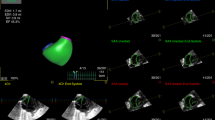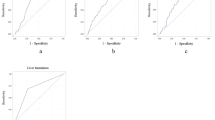Abstract
Objective:
To compare echocardiographic measures of biventricular function and pulmonary artery size in infants with congenital diaphragmatic hernia (CDH) and normal controls, and examine their correlation, if any, with outcomes in CDH.
Study Design:
We included consecutive neonates (<1 month old) with CDH and term controls without structural heart defects. Clinical and outcomes data were recorded and echocardiograms evaluated for right ventricular (RV) and left ventricular (LV) myocardial performance index (MPI), cardiac output index (CI) and McGoon index, among others. Statistical analyses (SPSS version 17, SPSS, Chicago, IL, USA) included between-group comparisons, using analysis of variance and χ2-test and binary regression, with significance set at P<0.05.
Result:
Infants with CDH (n=34) were comparable with controls (n=35) in their age, weight, gestational age and gender. CDH was left sided in 24 (70%) neonates. Extracorporeal membrane oxygenation (ECMO) was required in 15 (45%) neonates; 18 (53%) infants survived. MPIs, CI and eccentricity index in systole were significantly worse in the CDH group, compared with controls and among CDH infants who died, compared with survivors. Infants with CDH who died or needed ECMO had significantly impaired MPIs and CI than survivors. On regression analyses, LV CI and MPIs were independently associated with mortality.
Conclusion:
Infants with CDH had significantly impaired ventricular function and pulmonary hypertension, compared with controls. In the CDH group, LV dysfunction was associated with death and adverse outcomes. Further studies incorporating echocardiographic indices as prognostic markers of CDH are warranted.
This is a preview of subscription content, access via your institution
Access options
Subscribe to this journal
Receive 12 print issues and online access
$259.00 per year
only $21.58 per issue
Buy this article
- Purchase on Springer Link
- Instant access to full article PDF
Prices may be subject to local taxes which are calculated during checkout


Similar content being viewed by others
References
Colvin J, Bower C, Dickinson JE, Sokol J . Outcomes of congenital diaphragmatic hernia: a population-based study in western Australia. Pediatrics 2005; 116 (3): e356–e363.
Dillon PW, Cilley RE, Mauger D, Zachary C, Meier A . The relationship of pulmonary artery pressure and survival in congenital diaphragmatic hernia. J Pediatr Surg 2004; 39 (3): 307–312; discussion 307–312.
Chin KM, Kim NH, Rubin LJ . The right ventricle in pulmonary hypertension. Coron Artery Dis 2005; 16 (1): 13–18.
Tiefenbrunn LJ, Riemenschneider TA . Persistent pulmonary hypertension of the newborn. Am Heart J 1986; 111 (3): 564–572.
Skinner JR, Hunter S, Hey EN . Haemodynamic features at presentation in persistent pulmonary hypertension of the newborn and outcome. Arch Dis Child Fetal Neonatal Ed 1996; 74 (1): F26–F32.
Boucek Jr RJ, Martinez R . Echocardiographic determination of right ventricular function. Cardiol Young 2005; 15 (Suppl 1): 48–50.
Eidem BW, O’Leary PW, Tei C, Seward JB . Usefulness of the myocardial performance index for assessing right ventricular function in congenital heart disease. Am J Cardiol 2000; 86 (6): 654–658.
Eidem BW, Tei C, O’Leary PW, Cetta F, Seward JB . Nongeometric quantitative assessment of right and left ventricular function: myocardial performance index in normal children and patients with Ebstein anomaly. J Am Soc Echocardiogr 1998; 11 (9): 849–856.
Yeo TC, Dujardin KS, Tei C, Mahoney DW, McGoon MD, Seward JB . Value of a Doppler-derived index combining systolic and diastolic time intervals in predicting outcome in primary pulmonary hypertension. Am J Cardiol 1998; 81 (9): 1157–1161.
Dyer KL, Pauliks LB, Das B, Shandas R, Ivy D, Shaffer EM et al. Use of myocardial performance index in pediatric patients with idiopathic pulmonary arterial hypertension. J Am Soc Echocardiogr 2006; 19 (1): 21–27.
Fraisse A, Geva T, Gaudart J, Wessel DL . Doppler echocardiographic predictors of outcome in newborns with persistent pulmonary hypertension. Cardiol Young 2004; 14 (3): 277–283.
Peterson AL, Deatsman S, Frommelt MA, Mussatto K, Frommelt PC . Correlation of echocardiographic markers and therapy in persistent pulmonary hypertension of the newborn. Pediatr Cardiol 2009; 30 (2): 160–165.
Hasegawa S, Kohno S, Sugiyama T, Sato Y, Seki S, Yagyu M et al. Usefulness of echocardiographic measurement of bilateral pulmonary artery dimensions in congenital diaphragmatic hernia. J Pediatr Surg 1994; 29 (5): 622–624.
Okazaki T, Okawada M, Shiyanagi S, Shoji H, Shimizu T, Tanaka T et al. Significance of pulmonary artery size and blood flow as a predictor of outcome in congenital diaphragmatic hernia. Pediatr Surg Int 2008; 24 (12): 1369–1373.
Suda K, Bigras JL, Bohn D, Hornberger LK, McCrindle BW . Echocardiographic predictors of outcome in newborns with congenital diaphragmatic hernia. Pediatrics 2000; 105 (5): 1106–1109.
Lally KP, Lally PA, Lasky RE, Tibboel D, Jaksic T, Wilson JM et al. Defect size determines survival in infants with congenital diaphragmatic hernia. Pediatrics 2007; 120 (3): e651–e657.
Ryan T, Petrovic O, Dillon JC, Feigenbaum H, Conley MJ, Armstrong WF . An echocardiographic index for separation of right ventricular volume and pressure overload. J Am Coll Cardiol 1985; 5 (4): 918–927.
Sholler GF, Celermajer JM, Whight CM, Bauman AE . Echo Doppler assessment of cardiac output and its relation to growth in normal infants. Am J Cardiol 1987; 60 (13): 1112–1116.
Vuletin JF, Lim FY, Cnota J, Kline-Fath B, Salisbury S, Haberman B et al. Prenatal pulmonary hypertension index: novel prenatal predictor of severe postnatal pulmonary artery hypertension in antenatally diagnosed congenital diaphragmatic hernia. J Pediatr Surg 2010; 45 (4): 703–708.
Hsiao SH, Wang WC, Yang SH, Lee CY, Chang SM, Lin SK et al. Myocardial tissue Doppler-based indexes to distinguish right ventricular volume overload from right ventricular pressure overload. Am J Cardiol 2008; 101 (4): 536–541.
Patel N, Mills JF, Cheung MM . Use of the myocardial performance index to assess right ventricular function in infants with pulmonary hypertension. Pediatr Cardiol 2009; 30 (2): 133–137.
Author information
Authors and Affiliations
Corresponding author
Ethics declarations
Competing interests
The authors declare no conflict of interest.
Rights and permissions
About this article
Cite this article
Aggarwal, S., Stockmann, P., Klein, M. et al. Echocardiographic measures of ventricular function and pulmonary artery size: prognostic markers of congenital diaphragmatic hernia?. J Perinatol 31, 561–566 (2011). https://doi.org/10.1038/jp.2011.3
Received:
Revised:
Accepted:
Published:
Issue Date:
DOI: https://doi.org/10.1038/jp.2011.3
Keywords
This article is cited by
-
Early echocardiographic pulmonary artery measurements as prognostic indicators in left congenital diaphragmatic hernia
BMC Pediatrics (2023)
-
Ventricular function in congenital diaphragmatic hernia: a systematic review and meta-analysis
European Journal of Pediatrics (2022)
-
Cardiac Function Assessments in Left Bochdalek’s Hernia: Clinical Relevance
Pediatric Cardiology (2018)
-
Current Concepts in the Management of Congenital Diaphragmatic Hernia in Infants
Indian Journal of Surgery (2015)
-
Longitudinal Systolic Left Ventricular Function in Preterm and Term Neonates: Reference Values of the Mitral Annular Plane Systolic Excursion (MAPSE) and Calculation of z-Scores
Pediatric Cardiology (2015)



